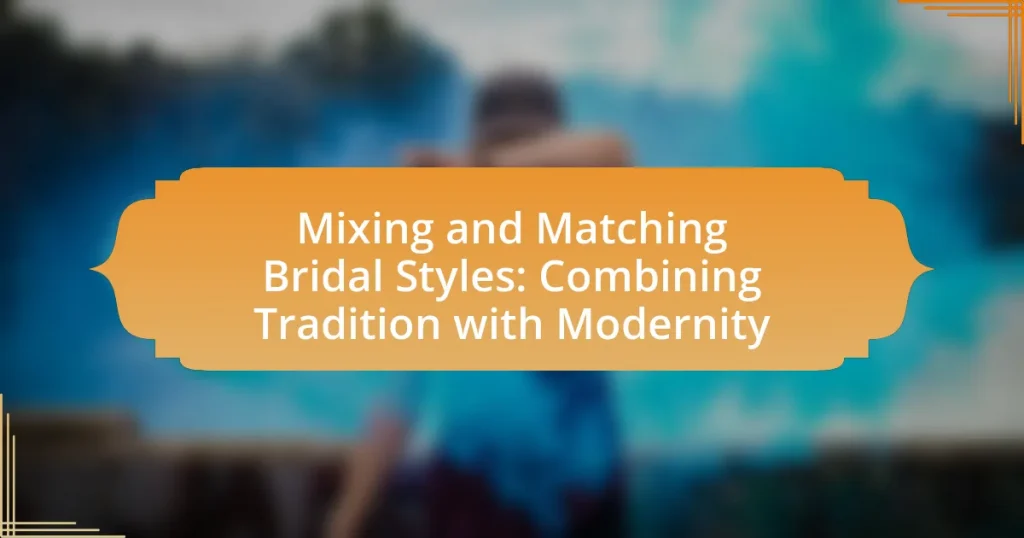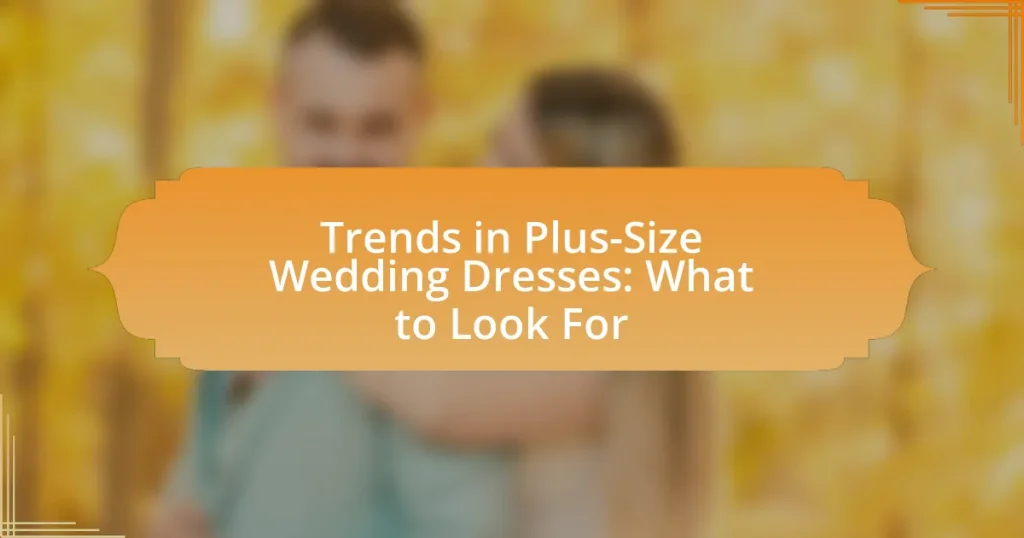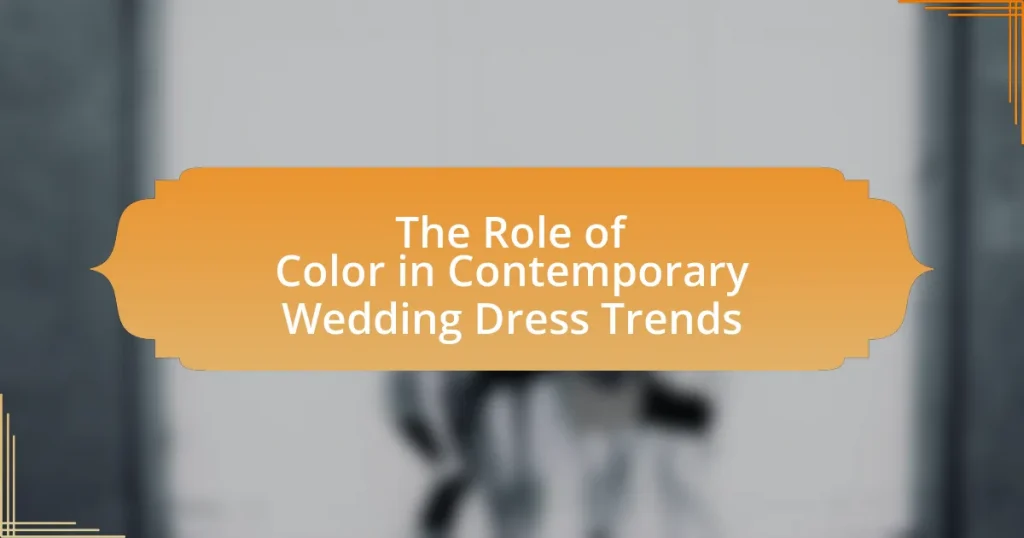Mixing and matching bridal styles involves the integration of traditional and contemporary elements to create a personalized wedding look. This article explores how brides can effectively combine classic attire with modern accessories, highlighting key features of both traditional and modern bridal styles. It discusses the cultural influences on bridal choices, the benefits of personalization, and the challenges faced when blending styles. Additionally, the article provides practical tips for achieving a cohesive look, the role of accessories, and successful examples from real brides and celebrities, emphasizing the growing trend of individualized bridal fashion.

What does Mixing and Matching Bridal Styles entail?
Mixing and matching bridal styles entails the combination of various elements from traditional and contemporary wedding attire to create a unique look. This approach allows brides to personalize their wedding outfits by selecting different silhouettes, fabrics, and embellishments that reflect their individual tastes while honoring cultural or familial traditions. For example, a bride might pair a classic lace gown with modern accessories or choose a traditional veil with a contemporary dress design. This blending of styles not only showcases personal style but also adapts to diverse wedding themes and settings, making it increasingly popular in modern bridal fashion.
How can traditional and modern bridal styles be combined?
Traditional and modern bridal styles can be combined by integrating classic elements, such as lace or embroidery, with contemporary silhouettes and fabrics. For instance, a bride might wear a traditional lace gown but choose a modern cut, like a sleek mermaid shape, to create a balance between old and new. This approach allows for the preservation of cultural significance while embracing current fashion trends, as seen in the increasing popularity of hybrid designs that feature both vintage and modern aesthetics.
What are the key elements of traditional bridal styles?
The key elements of traditional bridal styles include specific attire, cultural symbolism, and customary accessories. Traditional bridal attire often features garments such as gowns, saris, or kimonos that reflect cultural heritage, with intricate designs and fabrics that signify status and tradition. Cultural symbolism is evident in the colors chosen, such as red for luck in many Asian cultures or white for purity in Western traditions. Additionally, customary accessories like veils, tiaras, or jewelry play a significant role, often carrying historical significance or family heritage. These elements collectively create a cohesive representation of cultural identity and values in bridal fashion.
What are the defining features of modern bridal styles?
Modern bridal styles are characterized by a blend of contemporary aesthetics and traditional elements, emphasizing personalization and versatility. Key features include minimalist designs, non-traditional silhouettes, and the use of diverse fabrics such as lace, tulle, and crepe. Additionally, modern brides often opt for unique color palettes beyond classic white, incorporating shades like blush, champagne, or even bold colors. Accessories play a significant role, with many brides choosing statement pieces like capes, headpieces, or personalized jewelry to enhance their look. This evolution reflects a shift towards individual expression in bridal fashion, allowing brides to curate their wedding attire to match their personal style and cultural backgrounds.
Why is the trend of mixing bridal styles gaining popularity?
The trend of mixing bridal styles is gaining popularity because it allows brides to express their individuality while blending traditional and modern elements. This approach caters to diverse cultural backgrounds and personal tastes, enabling brides to create a unique look that reflects their identity. According to a survey by The Knot, 30% of brides in recent years have opted for non-traditional wedding attire, showcasing a shift towards personalization in bridal fashion. This trend not only embraces various styles but also encourages creativity, making each wedding a distinctive celebration.
How does cultural influence play a role in bridal style choices?
Cultural influence significantly shapes bridal style choices by dictating the traditions, colors, and attire that are deemed appropriate for weddings. For instance, in many Western cultures, white dresses symbolize purity and are a common choice, while in Indian culture, red is favored for its auspiciousness and is often worn by brides. This cultural significance is supported by historical practices; for example, Queen Victoria popularized the white wedding dress in the 19th century, which has since become a standard in Western weddings. Additionally, cultural rituals, such as the Chinese custom of wearing multiple dresses throughout the wedding day, further illustrate how cultural backgrounds inform bridal fashion decisions.
What are the benefits of personalizing bridal attire?
Personalizing bridal attire enhances the uniqueness and emotional significance of the wedding experience. Customization allows brides to express their individual style, ensuring that their attire reflects personal tastes and cultural backgrounds. This tailored approach can lead to increased satisfaction, as studies indicate that personalized experiences contribute to higher levels of happiness and fulfillment. Additionally, personalized bridal attire can incorporate meaningful elements, such as family heirlooms or specific colors that hold sentimental value, further enriching the overall wedding narrative.

What are the challenges of Mixing and Matching Bridal Styles?
Mixing and matching bridal styles presents challenges such as achieving visual harmony, maintaining a cohesive theme, and addressing differing fabric textures and colors. Visual harmony is crucial, as mismatched styles can create a disjointed appearance; for instance, combining a vintage lace gown with modern minimalist accessories may clash aesthetically. Maintaining a cohesive theme is essential to ensure that all elements, from the dress to the veil and shoes, complement each other, which can be difficult when drawing from diverse styles. Additionally, differing fabric textures and colors can complicate the overall look; for example, pairing a satin dress with a tulle veil may not create the desired effect if the shades do not align. These challenges require careful consideration and planning to achieve a successful blend of traditional and modern bridal elements.
How can brides effectively blend different styles?
Brides can effectively blend different styles by selecting elements from both traditional and modern aesthetics that complement each other. For instance, a bride might choose a classic lace gown while incorporating contemporary accessories like a sleek veil or bold jewelry. This approach allows for a harmonious balance, as seen in the trend of pairing vintage silhouettes with modern fabrics, which has gained popularity in recent years. By thoughtfully combining these elements, brides can create a unique look that reflects their personal style while honoring tradition.
What common mistakes should be avoided when mixing styles?
When mixing styles, common mistakes to avoid include failing to establish a cohesive theme, which can lead to a disjointed appearance. A lack of balance between traditional and modern elements often results in visual confusion, making it essential to select pieces that complement each other. Additionally, over-accessorizing can detract from the overall look, as too many contrasting elements can overwhelm the design. Choosing colors that clash rather than harmonize can also disrupt the intended aesthetic. Finally, neglecting to consider the venue’s atmosphere may result in a mismatch between the bridal style and the setting, undermining the overall effect.
How can color palettes be harmonized across styles?
Color palettes can be harmonized across styles by utilizing a cohesive color theory that emphasizes complementary and analogous colors. This approach ensures that colors from different styles blend seamlessly, creating a unified aesthetic. For instance, a traditional bridal style featuring soft pastels can be harmonized with a modern style by incorporating bold accents that share undertones with the pastels, thus maintaining visual balance. Research in color psychology indicates that colors evoke specific emotions and associations, which can be strategically used to enhance the overall theme of a bridal event. By selecting colors that resonate with both traditional and modern elements, designers can create a visually appealing and cohesive palette that respects the essence of both styles.
What role do accessories play in combining styles?
Accessories serve as crucial elements in combining styles, particularly in the context of mixing traditional and modern bridal aesthetics. They enhance the overall look by bridging the gap between different fashion influences, allowing for a cohesive yet diverse appearance. For instance, a classic veil can be paired with contemporary jewelry to create a balanced ensemble that honors tradition while embracing modern trends. This blending is supported by fashion studies indicating that accessories can significantly alter the perception of an outfit, making them essential for achieving a harmonious style fusion.
How can accessories enhance the overall look?
Accessories can enhance the overall look by adding depth, personality, and cohesion to an outfit. For instance, in bridal fashion, accessories such as veils, jewelry, and hairpieces can complement the gown’s design and color, creating a harmonious appearance. Studies show that well-chosen accessories can elevate an outfit’s perceived value and style, with a survey indicating that 70% of individuals believe accessories significantly impact overall aesthetics. Therefore, the strategic use of accessories not only highlights the bride’s unique style but also reinforces the theme of mixing traditional and modern elements in bridal attire.
What types of accessories work best with mixed styles?
Accessories that work best with mixed styles include statement jewelry, versatile belts, and layered textures. Statement jewelry, such as bold necklaces or oversized earrings, can bridge traditional and modern elements, enhancing the overall look. Versatile belts can cinch the waist and add structure, making them suitable for both classic and contemporary silhouettes. Layered textures, like combining lace with metal or fabric with beads, create visual interest and harmonize different styles. These accessories effectively complement mixed bridal styles by providing cohesion and enhancing the unique blend of tradition and modernity.

What are some successful examples of Mixing and Matching Bridal Styles?
Successful examples of mixing and matching bridal styles include combining a traditional ball gown with a modern lace crop top, which allows brides to blend classic elegance with contemporary flair. Another example is pairing a vintage-inspired A-line dress with a sleek, minimalist veil, creating a harmonious balance between old-world charm and modern simplicity. Additionally, brides often mix different fabrics, such as satin and tulle, to achieve a unique look that reflects both personal style and cultural heritage. These combinations have gained popularity, as they allow for personalization while honoring traditional elements, showcasing the evolving nature of bridal fashion.
How have real brides successfully combined styles?
Real brides have successfully combined styles by blending traditional elements with modern aesthetics, creating unique and personalized wedding looks. For instance, many brides incorporate classic lace or satin fabrics into contemporary silhouettes, such as A-line or mermaid gowns, which allows them to honor tradition while embracing current fashion trends. Additionally, brides often mix accessories, like pairing vintage jewelry with modern hairstyles or wearing a traditional veil with a non-traditional dress. This approach not only reflects their individual tastes but also resonates with the growing trend of personalized weddings, where 70% of couples opt for a mix of styles to create a distinctive celebration.
What are some notable celebrity examples of mixed bridal styles?
Notable celebrity examples of mixed bridal styles include Priyanka Chopra, who blended traditional Indian attire with Western elements in her wedding to Nick Jonas, showcasing a fusion of cultures. Another example is Meghan Markle, who incorporated modern design with classic elements in her Givenchy wedding dress, reflecting both contemporary and traditional bridal aesthetics. Additionally, Solange Knowles wore a unique jumpsuit for her wedding to Alan Ferguson, merging modern fashion with traditional bridal significance. These examples illustrate how celebrities creatively combine various styles to reflect personal identity and cultural heritage in their weddings.
How can inspiration be drawn from different cultures?
Inspiration can be drawn from different cultures by exploring their unique traditions, aesthetics, and practices related to bridal styles. For instance, incorporating elements such as intricate henna designs from South Asian weddings or the use of vibrant colors and patterns from African ceremonies can enhance modern bridal looks. Historical evidence shows that cross-cultural influences have enriched fashion; for example, the adoption of lace from European traditions into various bridal gowns has created diverse styles that appeal to a global audience. This blending of cultural elements not only celebrates diversity but also allows for innovative expressions in contemporary bridal fashion.
What tips can help brides achieve a cohesive look?
Brides can achieve a cohesive look by selecting a consistent color palette and coordinating styles across their attire and accessories. This approach ensures that all elements, from the wedding dress to the bridesmaids’ outfits and floral arrangements, complement each other visually. For instance, choosing shades of white and blush for the dress and bouquets creates harmony. Additionally, incorporating similar fabrics or design elements, such as lace or embroidery, can further unify the overall aesthetic. Research indicates that a well-coordinated color scheme enhances visual appeal and creates a memorable experience for guests.
How can a bridal stylist assist in the mixing process?
A bridal stylist can assist in the mixing process by providing expert guidance on how to blend traditional and modern bridal elements effectively. They analyze the bride’s personal style, preferences, and the overall theme of the wedding to create a cohesive look that honors tradition while incorporating contemporary trends. For instance, a bridal stylist may suggest pairing a classic lace gown with modern accessories, such as a sleek veil or statement jewelry, ensuring that the final ensemble reflects both the bride’s individuality and the wedding’s aesthetic. This tailored approach not only enhances the bride’s appearance but also ensures that the mixed styles harmonize seamlessly, resulting in a unique and memorable bridal look.
What are the best practices for fitting and alterations in mixed styles?
The best practices for fitting and alterations in mixed styles involve a thorough understanding of both traditional and modern design elements. First, ensure that the silhouette of the garment complements the body shape while integrating features from both styles, such as a classic bodice with a contemporary skirt. Second, prioritize the use of high-quality materials that can seamlessly blend the two styles, ensuring durability and comfort. Third, conduct multiple fittings to assess how the garment adapts to the wearer’s movements, allowing for adjustments that maintain the integrity of both styles. Finally, consult with a skilled tailor experienced in mixed styles to achieve a cohesive look, as their expertise can significantly enhance the final outcome.



